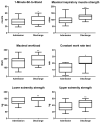Outpatient Pulmonary Rehabilitation in Patients with Persisting Symptoms after Pulmonary Embolism
- PMID: 32532020
- PMCID: PMC7355580
- DOI: 10.3390/jcm9061811
Outpatient Pulmonary Rehabilitation in Patients with Persisting Symptoms after Pulmonary Embolism
Abstract
Background: Patients with pulmonary embolism (PE) may suffer from long-term consequences, including decreased functional capacity. Data on pulmonary rehabilitation (PR) in patients with PE are scarce, and no data on outpatient PR are available so far. Methods: We analyzed data of 22 PE patients who attended outpatient PR due to exertional dyspnea. Patients underwent a multi-professional 6-week PR program. The primary outcome was change in 6-min walk test (6MWT). Secondary outcomes included changes in strength and endurance tests. To assess long-term benefits, follow-up was performed a median of 39 months after PR. Results: Patients started PR a median of 19 weeks after the acute PE event. Their median age was 47.5 years, 33% were women and all presented with NYHA (New York Heart Association) class II and higher. After PR, patients showed significant and clinically relevant improvements in 6MWT (mean difference: 49.4 m [95% CI 32.0-66.8]). Similarly, patients increased performance in maximum strength, endurance and inspiratory muscle strength. At long-term follow-up, 78% of patients reported improved health. Conclusion: We observed significant improvements in exercise capacity in PE patients undergoing outpatient PR. The majority of patients also reported a long-term improvement in health status. Prospective studies are needed to identify patients who would benefit most from structured PR.
Keywords: dyspnea; exercise training; outpatient; pulmonary embolism; pulmonary rehabilitation.
Conflict of interest statement
The authors declare no conflict of interest.
Figures




Similar articles
-
Rehabilitation post pulmonary embolism: Preliminary data.Int J Cardiol Cardiovasc Risk Prev. 2024 Apr 29;21:200269. doi: 10.1016/j.ijcrp.2024.200269. eCollection 2024 Jun. Int J Cardiol Cardiovasc Risk Prev. 2024. PMID: 39118981 Free PMC article. Review. No abstract available.
-
The Effects of a 10-wk Outpatient Pulmonary Rehabilitation Program on Exercise Performance, Muscle Strength, Soluble Biomarkers, and Quality of Life in Patients With Pulmonary Hypertension.J Cardiopulm Rehabil Prev. 2019 Nov;39(6):397-402. doi: 10.1097/HCR.0000000000000443. J Cardiopulm Rehabil Prev. 2019. PMID: 31592929
-
The Efficacy of Outpatient Pulmonary Rehabilitation After Bilateral Lung Transplantation.J Cardiopulm Rehabil Prev. 2019 Jul;39(4):E7-E12. doi: 10.1097/HCR.0000000000000391. J Cardiopulm Rehabil Prev. 2019. PMID: 31241521
-
The effects of inspiratory muscle training on exercise capacity, dyspnea and respiratory functions in lung transplantation candidates: a randomized controlled trial.Clin Rehabil. 2018 Oct;32(10):1328-1339. doi: 10.1177/0269215518777560. Epub 2018 May 30. Clin Rehabil. 2018. PMID: 29843525 Clinical Trial.
-
Effects of inspiratory muscle training in COPD patients: A systematic review and meta-analysis.Clin Respir J. 2018 Jul;12(7):2178-2188. doi: 10.1111/crj.12905. Epub 2018 May 23. Clin Respir J. 2018. PMID: 29665262
Cited by
-
Application of pulmonary rehabilitation in patients with pulmonary embolism (Review).Exp Ther Med. 2022 Jan;23(1):96. doi: 10.3892/etm.2021.11019. Epub 2021 Dec 1. Exp Ther Med. 2022. PMID: 34976138 Free PMC article. Review.
-
Rehabilitation post pulmonary embolism: Preliminary data.Int J Cardiol Cardiovasc Risk Prev. 2024 Apr 29;21:200269. doi: 10.1016/j.ijcrp.2024.200269. eCollection 2024 Jun. Int J Cardiol Cardiovasc Risk Prev. 2024. PMID: 39118981 Free PMC article. Review. No abstract available.
-
Sequelae of Acute Pulmonary Embolism: From Post-Pulmonary Embolism Functional Impairment to Chronic Thromboembolic Disease.J Clin Med. 2024 Oct 30;13(21):6510. doi: 10.3390/jcm13216510. J Clin Med. 2024. PMID: 39518648 Free PMC article. Review.
-
Long-Term Management of Pulmonary Embolism: A Review of Consequences, Treatment, and Rehabilitation.J Clin Med. 2022 Oct 10;11(19):5970. doi: 10.3390/jcm11195970. J Clin Med. 2022. PMID: 36233833 Free PMC article. Review.
-
Exercise capacity, dyspnea, and quality of life 6 months after exercise-based rehabilitation in patients with persistent dyspnea following pulmonary embolism.Res Pract Thromb Haemost. 2025 Mar 19;9(2):102736. doi: 10.1016/j.rpth.2025.102736. eCollection 2025 Feb. Res Pract Thromb Haemost. 2025. PMID: 40242191 Free PMC article.
References
-
- Barco S., Mahmoudpour S.H., Valerio L., Klok F.A., Münzel T., Middeldorp S., Ageno W., Cohen A.T., Hunt B.J., Konstantinides S.V. Trends in mortality related to pulmonary embolism in the European Region, 2000–15: Analysis of vital registration data from the WHO Mortality Database. Lancet Respir. Med. 2020;8:277–287. doi: 10.1016/S2213-2600(19)30354-6. - DOI - PubMed
LinkOut - more resources
Full Text Sources
Research Materials

